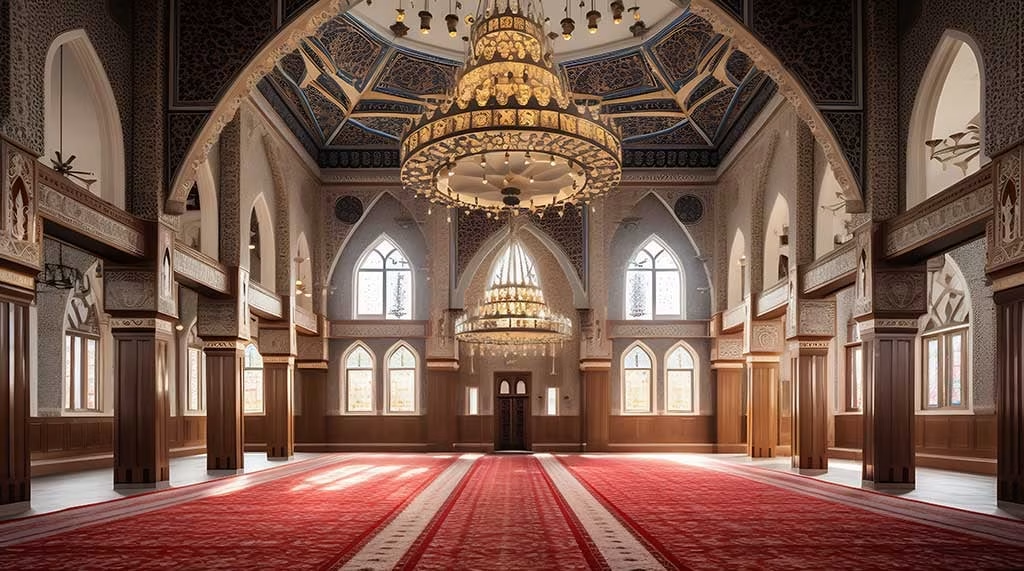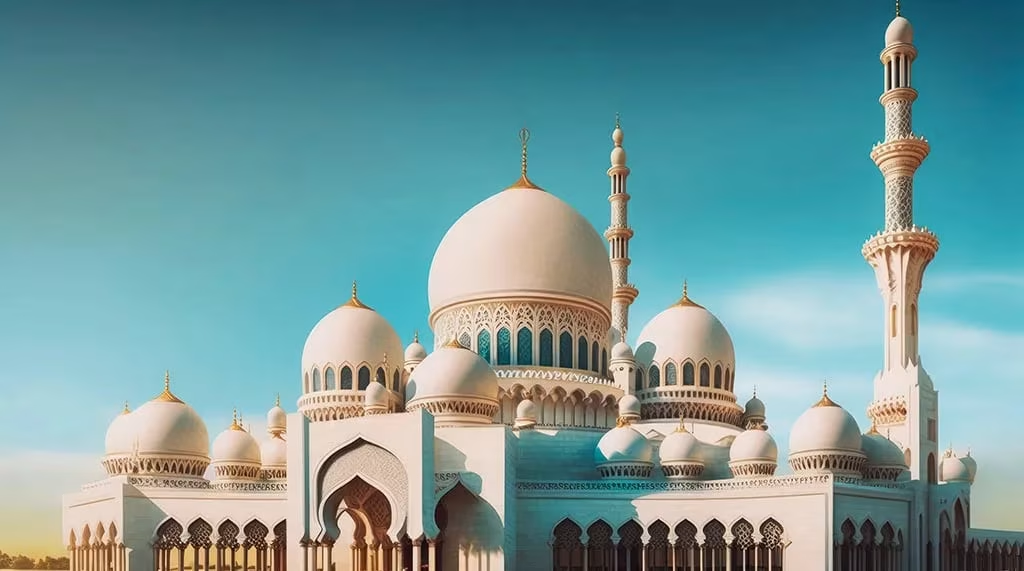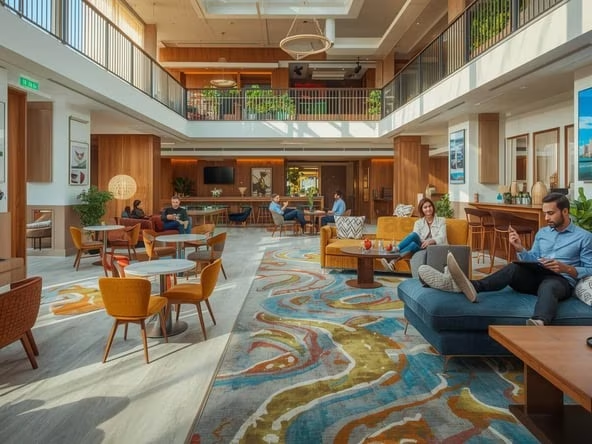Although Dubai is renowned for its luxurious buildings, fascinating malls, and diverse business opportunities, it is also home to some of the world’s most impressive mosques. The city’s rich Islamic heritage and architectural diversity have made it a wonderful place to visit, featuring beautiful mosques with eye-catching designs and styles.
In this article, we will introduce and explore some of the most famous mosques in Dubai. All you need to know about them and how to visit is here for you. If you are planning to move to Dubai or simply scheduling a trip, follow this article for complete information and a comprehensive guide to Dubai’s mosques.
Top 5 Must-Visit Mosques in Dubai
1. Jumeirah Mosque
Known as the most photographed mosque in Dubai, Jumeirah Mosque is a symbol of Islamic architecture, eastern beauty, and hospitality. Entirely built from white stone in the medieval Fatimid tradition, the mosque features twin minarets and a large central dome adorned with intricate carvings and floral patterns. Whether you are a muslim visiting for religious rituals or just a tourist, you would be amazed at this mosque.
Located along Jumeirah Beach Road, the center offers guided tours six days a week through the Sheikh Mohammed Centre for Cultural Understanding. This is one of the few mosques that is open to non-muslims as well, so don’t worry if you hold different beliefs or a different religion. Guided tours provide insights into Islamic beliefs, traditions, and the meaning of prayer.
The Jumeirah Mosque is primarily tourist-oriented and usually crowded, so be sure to check the visiting hours and peak times to avoid traffic congestion. Additionally, numerous public transportation options are available to reach the Jumeirah Mosque.

How to Get There:
- By Metro: Red Line to Al Jafiliya Station; ~10-minute taxi or bus ride from there.
- By Bus: Routes 8, 9, C10, X28 stop at Jumeirah Mosque 1; ~5-minute walk.
- By Taxi: Around 15–20 minutes from Downtown Dubai.
2. Al Farooq Omar Bin Al Khattab Mosque
Al Farooq, which is also known as the Blue Mosque, is an architectural masterpiece inspired by Istanbul’s Sultan Ahmed Mosque.
Located in Al Safa, the mosque features 21 domes, four minarets, and intricate, captivating Arabic calligraphy on its walls. It spans over 93,000 square feet and can accommodate more than 2,000 worshippers.
It features an extensive library and cultural center, with over 4,000 Islamic and scientific books in multiple languages. What sets this mosque apart is its unique blend of Andalusian and Ottoman architectural styles, making it one of Dubai’s most beautiful mosques. Al Farooq mosque is not just a tourist attraction for people to visit; it’s more like a cultural center for Islamic traditions and rituals.
How to Get There:
- By Metro: Take the Red Line to Noor Bank Station, then a taxi (~7 minutes).
- By Bus: Routes 12, 93, 81, F20, X28 stop near Al Safa; a short walk follows.
- By Taxi: Approximately 20–25 minutes from Downtown Dubai.
3. Grand Mosque (Bur Dubai)
The Grand Mosque is a center of Dubai’s religious and cultural heritage, situated in the historic Al Fahidi neighborhood. It’s famous for its tallest minarets, which stand at 70 meters. Although it was once repaired and rebuilt in 1998, its original Islamic architectural elements and spirit have remained intact.
The Grand Mosque (Bur Dubai) has over 50 domes and hosts up to 1,200 worshippers. Unlike the Jumeirah Mosque, this one is not open to non-Muslims; however, the exterior is fascinating and creates a scenic landscape. The juxtaposition of the Grand Mosque (Bur Dubai) with the Dubai Museum adds to its charm, especially at night when it’s beautifully lit and captivating.
How to Get There:
- By Metro: Green Line to Al Fahidi or Al Ghubaiba stations; ~10-minute walk.
- By Bus: Routes 29, 33, 44, 91, C1, E306, X13, X23 stop nearby.
- By Taxi: About 15 minutes from Downtown Dubai.
4. Al Salam Mosque
Opened in 2014, Al Salam Mosque is renowned for its distinctive design, which seamlessly blends traditional and contemporary architecture and aesthetics. Thanks to its red and white façade, tiered domes, and elegant minarets, Al Salam Mosque quickly became one of the prominent and visually striking places in Dubai.
The mosque houses over 1,500 worshippers and is often used and visited by locals and muslim residents for Friday prayers. Although it is less well-known and popular among tourists, symmetrical design, clean lines, and detailed craftsmanship make a place worth visiting and enjoying while wandering in the city.
How to Get There:
- By Metro: Red Line to First Gulf Bank Station; ~1-minute walk.
- By Bus: Routes 84, 93, and F30 stop nearby.
- By Taxi: Approximately 20 minutes from Downtown Dubai.
5. Khalifa Al Tajer Mosque
Few Islamic cities in the world have an eco-friendly mosque. Khalifa Al Tajer Mosque was built with sustainability and eco-friendly criteria in mind. Located near Deira, the Khalifa Al Tajer Mosque incorporates green building principles and guidelines, including the use of solar panels, energy-efficient lighting, and water-saving features. Besides being visually appealing, this mosque is an excellent example of efficient and captivating green architecture.
Khalifa Al Tajer Mosque can accommodate 3,500 worshippers and offer prayers in a space rich in Islamic symbols and traditions. Integrating the concept of environmental sustainability within the framework of Islamic values has made this mosque exceptional.
How to Get There:
- By Metro: Red Line to Deira City Centre Station; ~5-minute walk.
- By Bus: Routes stopping at Deira City Centre Bus Station.
- By Taxi: Around 15 minutes from Downtown Dubai.
Unique Architectural Features of Dubai’s Mosques
Dubai is a city of beauty and attractions. It’s no surprise that mosques are not limited to worship and doing religious rituals. They are renowned for their remarkable architectural characteristics and the fusion of modern concepts with traditional heritage. Integrating the contemporary and innovative aspects of the city with conventional Islamic architecture has made Dubai’s mosques unique masterpieces that are both enjoyable for tourists and Muslim residents.
The most engaging feature of Dubai’s mosque is that it offers a contemporary vision, rather than the traditional mosques with their old-fashioned and regular design. This capacity has made them interesting to visit even for non-muslim tourists. Whether you want to worship them or not, mosques are a significant part of the city’s charm and interesting vibe.
Jumeirah Mosque is a perfect example of an Islamic mosque smoothly combined with modern features and architecture. Centuries-old architectural details, combined with iconic landmarks built from creamy white stone, make the Jumeirah Mosque the masterpiece it is and a popular tourist attraction.
Tall minarets, a central dome, and delicate floral and geometric carvings, along with beautiful craftsmanship, stand out in Dubai’s mosques. Nowadays, you can see these beautiful mosques on every poster and video related to Dubai. They are often photographed and well-known by foreigners and tourists.
Together, these mosques display the city’s evolving architectural narrative, where past heritage is cherished and valued by integrating modern technology and design. The Islamic architectural legacy is not ignored; instead, it is used to elevate the city’s beauty and atmosphere.
Cultural Significance of Mosques in Dubai
Mosques in Dubai have evolved into cultural and community centers, offering educational services and making them more than just places for prayer and regular religious rituals. Numerous academic programs, community groups, and charitable events are held in these mosques, fostering a sense of unity and shared identity among residents and worshippers.
Additionally, these mosques are working to bridge the cultural and religious divides. For instance, the Sheikh Mohammed Centre for Cultural Understanding, situated near the Jumeirah Mosque, offers intercultural programs to foster dialogue and understanding among individuals with diverse religious and historical backgrounds.
The inclusive and diverse spirit of Dubai’s Islamic heritage is reflected in these programs. They also help and inspire tourists and residents alike to understand Emirati culture and the Islamic values and faiths in an honest and respectful environment.
Visiting Etiquette for Tourists at Mosques
To respect and value the sanctity of these religious places, there are some rules and etiquette that are essential for visitors, especially foreigners, to follow.
- Dress modestly and simply: Choose clothing that covers arms and legs. Women are also obligated to cover their hair with a scarf. It’s best to research the type and color of clothes you should wear in mosques before visiting.
- Remove Your Footwear: Take off your shoes before entering the prayer hall. It is essential to enter mosques without dirty shoes, as it is a sign of respect for these holy places.
- Maintain Silence: Speak softly and avoid disruptive behavior, such as shouting, eating loudly, or making interrupting noises in the prayer hall. It’s inappropriate to disrupt the silence of worshipers.
- Photography: Before taking any pictures, ask for permission, especially during prayer times or when worshippers are present. It’s not just about privacy and security, it’s also a way to pay respect to the holy place and religious rituals.
Before visiting mosques, check whether non-Muslims are allowed or not. Some mosques, such as the Jumeirah Mosque, are designed to welcome non-Muslim visitors and are open to foreigners regardless of their religion. Moreover, helpful guides are offered for an in-depth exploration of Islam’s role in daily life, the format of prayers, principles of Islamic art and design, popular Islamic events, and festivals.
Events and Festivals Celebrated at Mosques in Dubai
Numerous religious events and festivals are hosted by mosques in Dubai, including special prayers and community gatherings during Ramadan, Eid al-Fitr, and Eid al-Adha. Ramadan and Eid al-Fitr are renowned for their diverse range of foods and rituals among Muslims. They are the best time for tourists to visit Dubai’s mosques, if they would like to learn more about the cultural and Islamic values associated with these places.
During Ramadan, many mosques offer Iftar meals, Taraweeh prayers, and cultural programs. Festivals bring people together for worship and celebration, often greeting guests from all backgrounds. It’s best to do your research first before participating in these festivals, making sure to know every ritual and principle of these events, helps you to have a more enjoyable time.
Best Times to Visit Mosques in Dubai
Considering the hot weather in Dubai, it’s ideal to visit mosques during the cooler months, from November to February, when the weather is pleasant and cooler, ensuring more enjoyable tours and walking. These months also feature several cultural events and festivals, contributing to the city’s vibrant atmosphere.
Visiting during Ramadan offers a spiritual and cultural experience, providing a genuine understanding of the holy month of fasting and its unique culinary offerings. While non-Muslims are welcome in some mosques, some local customs, such as abstaining from eating or drinking in public during daylight hours, are mandatory.
Additionally, prayer times are also sensitive, making it essential to check the Islamic prayer time in Dubai to avoid coinciding with them, ensuring a respectful and enriching experience for worshippers and tourists. You can verify this information online or ask the tour guides for confirmation.
Conclusion
Dubai mosques have become an integral part of the city’s charm and charisma. Whether you are a Muslim seeking a genuine atmosphere in a holy place or someone fascinated by the unique architectural heritage of these mosques, Dubai is a great option.



